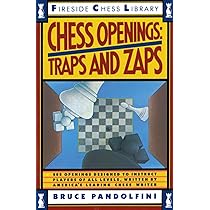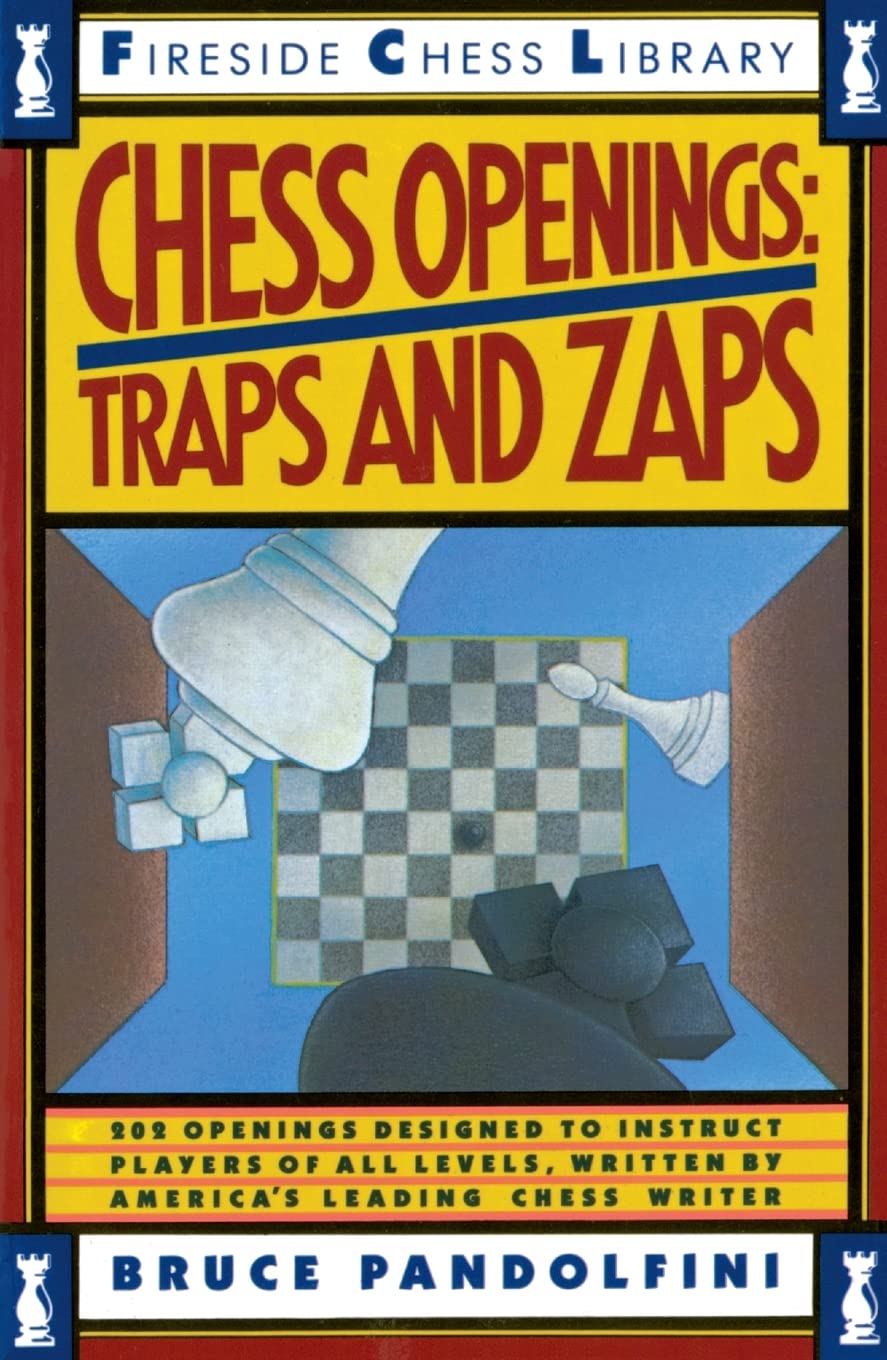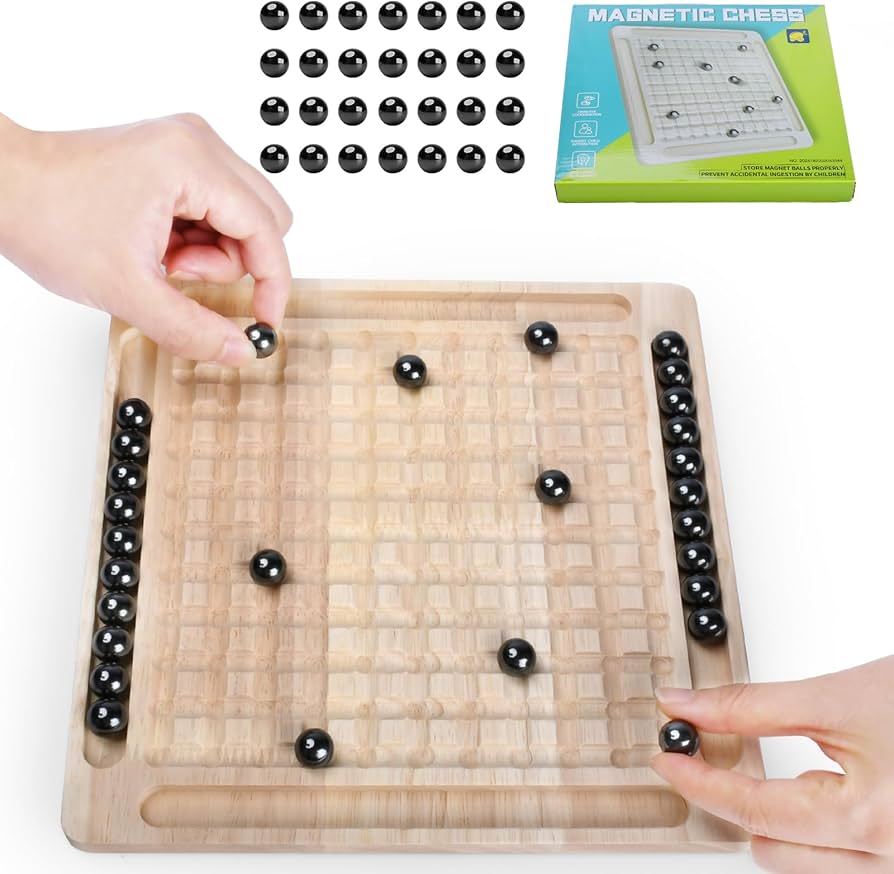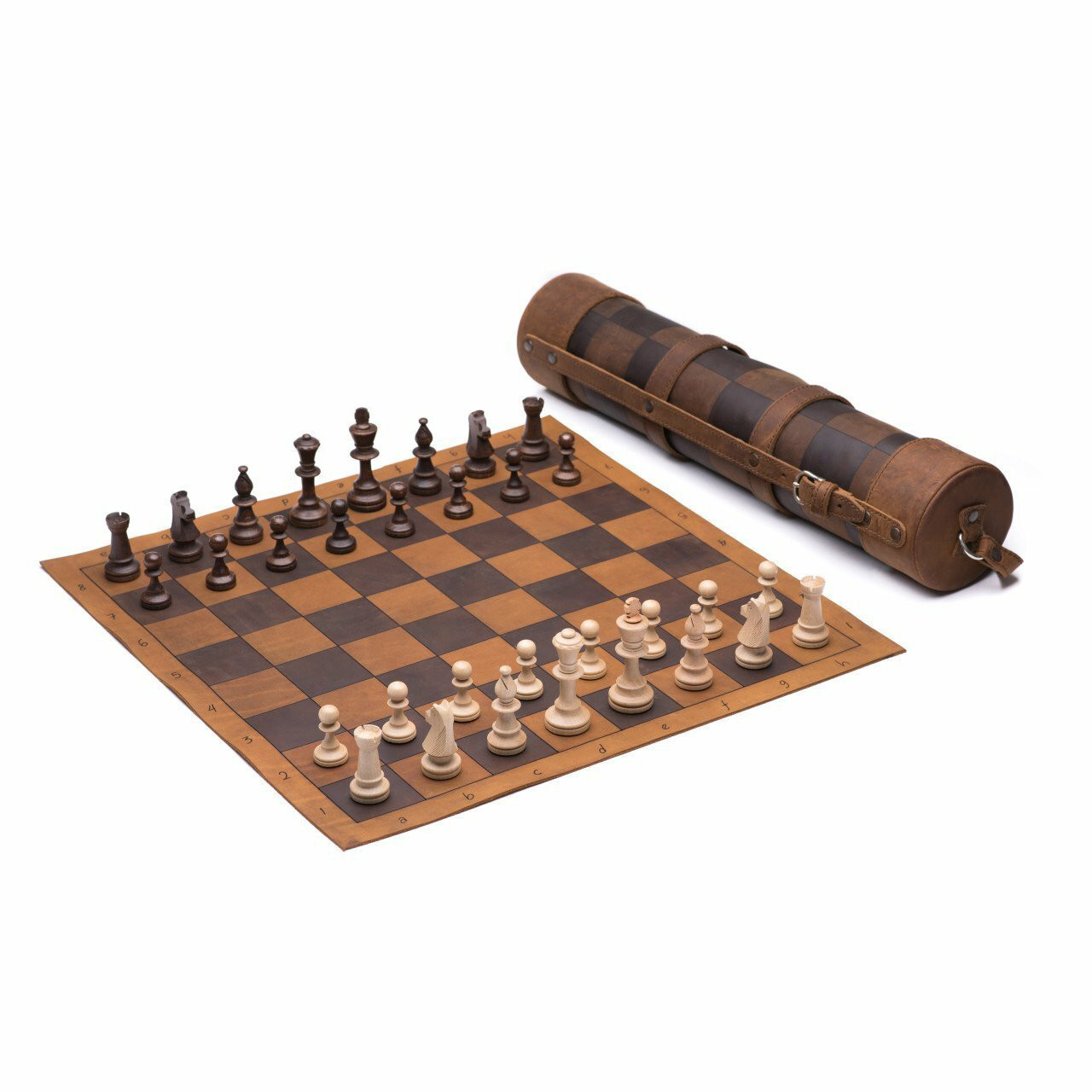Chess Openings Traps and Zaps by Bruce Pandolfini is a must-read for chess lovers. This book is perfect for players who want to catch opponents off guard.
Chess can be a complex game with many strategies and moves. “Chess Openings Traps and Zaps” helps simplify this complexity. Bruce Pandolfini, a renowned chess teacher, reveals clever traps and quick moves. This book is filled with tactics that can surprise your opponent early in the game.
Whether you’re a beginner or an advanced player, you’ll find valuable tips here. Pandolfini’s easy-to-understand style makes learning fun. Dive into this book and discover how to outsmart your opponents from the very first move.
Introduction To Chess Openings
Chess has fascinated players for centuries. A key aspect of this game is the opening. Understanding chess openings can significantly improve your game. Bruce Pandolfini’s “Chess Openings: Traps And Zaps” dives deep into this subject.
Importance Of Openings
Openings set the tone for the entire game. They can lead to a strong middle game or a quick loss. Good openings can give you control of the board early. Poor openings can lead to traps and zaps. Pandolfini highlights how crucial the first few moves are. They can dictate the flow of the game.
Common Opening Strategies
There are many strategies in chess openings. The King’s Pawn Opening is popular. It is aggressive and opens lines for the queen and bishop. The Queen’s Gambit is another common opening. It offers a pawn to control the center. The Sicilian Defense is a favorite among advanced players. It counters the King’s Pawn with an asymmetrical response.
Pandolfini explains these strategies in detail. He also covers less common openings. Understanding these can give you an edge. Knowing how to respond to various openings is key. It helps in avoiding traps and setting up your own zaps.
About Bruce Pandolfini
Bruce Pandolfini is a well-known figure in the world of chess. He has made significant contributions to the game. His book, “Chess Openings: Traps and Zaps,” is a testament to his expertise.
Career Highlights
Pandolfini’s chess career is filled with notable achievements. He started his journey as a chess player and quickly made a name for himself.
- He became a National Master in 1970.
- He played in the U.S. Championship in 1974.
- He has coached many young talents.
His career is not just about playing. He is also a renowned chess teacher and author.
Contributions To Chess
Pandolfini has contributed to chess in many ways. His work as a coach and author has had a lasting impact.
Some of his contributions include:
- He has written over 30 chess books.
- He has coached players who have become Grandmasters.
- He is a regular columnist for Chess Life magazine.
His books are a valuable resource for chess enthusiasts. They cover various aspects of the game.
His teaching methods are appreciated worldwide. He uses clear and simple language, making chess accessible to everyone.
| Contribution | Details |
|---|---|
| Books | Written over 30 books on chess. |
| Coaching | Coached players who became Grandmasters. |
| Columnist | Regular columnist for Chess Life magazine. |
Bruce Pandolfini’s work continues to inspire chess players. His dedication to the game is evident in his numerous contributions.
Fundamental Traps In Chess
Chess is a game of strategy, foresight, and skill. Understanding fundamental traps can give you an edge over your opponent. Bruce Pandolfini’s book, “Chess Openings Traps And Zaps,” dives deep into these crucial elements. Let’s explore some classic and modern traps that can surprise your opponent.
Classic Traps
Classic traps have stood the test of time. They are tried-and-true strategies used by players for centuries. One example is the Fool’s Mate. This is the fastest checkmate possible, happening in just two moves. Another well-known trap is the Scholar’s Mate. This involves using the queen and bishop to deliver a quick checkmate. These traps rely on common mistakes made by beginners.
The Legal Trap is another example. It aims to catch an unsuspecting opponent. By pretending to lose a knight, you can set up a quick checkmate. The Blackburne Shilling Gambit is also a famous trap. It tricks the opponent into a premature attack. These traps are simple but effective.
Modern Traps
Modern traps adapt classic principles to contemporary play. They consider the evolving strategies of modern chess. One popular modern trap is the Fishing Pole Trap. This trap lures an opponent’s piece into a vulnerable position. Then, you counterattack decisively. Another example is the Noah’s Ark Trap. This involves trapping an opponent’s bishop on the edge of the board.
There’s also the Magnus Smith Trap. It uses the Sicilian Defense to create opportunities. By knowing these modern traps, you can stay ahead in competitive play. Understanding both classic and modern traps enriches your chess knowledge.

Credit: www.amazon.com
Effective Zaps In Openings
In the world of chess, openings set the stage for the entire game. Effective zaps can give you a significant advantage right from the start. Bruce Pandolfini’s book, “Chess Openings Traps And Zaps,” offers insights into these crafty moves. Understanding and using these zaps can help you surprise your opponent and gain the upper hand early on.
What Are Zaps?
Zaps are clever moves in chess openings. They aim to catch your opponent off guard. These moves can exploit their mistakes. Even a single zap can change the course of the game.
Examples Of Zaps
One famous zap is the Fried Liver Attack. This opening targets the opponent’s weak spot quickly. Another example is the Legal Trap. It tricks the opponent into losing a key piece early. These zaps are effective and memorable.
Another zap to consider is the Noah’s Ark Trap. This trap captures a bishop, leaving the opponent disadvantaged. The Englund Gambit Trap is also notable. It can force the opponent into a losing position fast. These examples show how zaps can be both simple and powerful.
Popular Opening Traps
Chess enthusiasts always seek ways to gain an edge in their games. Bruce Pandolfini’s book, Chess Openings Traps And Zaps, offers a wealth of knowledge. Understanding popular opening traps can help players catch their opponents off guard. Let’s delve into two well-known traps: the Fried Liver Attack and the Scholar’s Mate.
Fried Liver Attack
The Fried Liver Attack is an aggressive opening trap. It starts with the moves:
- e4 e5
- Nf3 Nc6
- Bc4 Nf6
- Ng5
White’s knight attacks the f7 pawn, aiming for a quick checkmate or a significant material advantage. Black needs to defend carefully to avoid losing the game early. This trap can lead to exciting and sharp positions.
Scholar’s Mate
The Scholar’s Mate is a famous trap. It aims to deliver checkmate in just four moves:
- e4 e5
- Qh5 Nc6
- Bc4 Nf6
- Qxf7#
In this sequence, White’s queen and bishop coordinate to checkmate the Black king. This trap is easy to learn and can catch beginners off guard. Proper defense involves developing pieces and controlling the center.
Both traps highlight the importance of opening knowledge. Mastering these can improve your chess game significantly.

Credit: www.rarebookcellar.com
Advanced Opening Traps
Exploring advanced opening traps in chess can elevate your game. Bruce Pandolfini’s book, “Chess Openings: Traps And Zaps,” delves deep into strategic traps. These traps can give you an upper hand early in the game. Let’s explore some advanced traps in popular openings.
Sicilian Defense Traps
The Sicilian Defense is a popular choice among chess players. It starts with 1.e4 c5. This opening can lead to many tricky traps. One common trap is the Poisoned Pawn Variation. Here, black can grab a pawn at the cost of safety. Another trap is the Smith-Morra Gambit. White sacrifices a pawn for rapid development. If black is unprepared, they can fall into tactical pitfalls.
Queen’s Gambit Traps
The Queen’s Gambit begins with 1.d4 d5 2.c4. It is a classic opening with many traps. One famous trap is the Elephant Trap. In this trap, black captures white’s knight, thinking it’s safe. But white has a hidden checkmate. Another trap is the Cambridge Springs Trap. Black sets a clever snare with well-placed pieces. White can lose material if they are not careful.
Avoiding Common Pitfalls
Chess is a game of strategy and skill. Even experienced players can fall into traps. Bruce Pandolfini’s book, Chess Openings Traps And Zaps, offers tips to avoid common mistakes. This section will help you recognize traps and counter your opponent’s moves effectively.
Recognizing Traps
Traps are sneaky moves that can catch you off guard. Here are some signs to watch for:
- Unusual Moves: If your opponent makes an unexpected move, be cautious.
- Quick Development: Rapid piece movement could lead to a trap.
- Weak Squares: Look for weaknesses in your position.
Understanding these signs can help you avoid falling into traps. Always think a few moves ahead. Be aware of the potential consequences of each move.
Countering Opponent’s Moves
Once you recognize a trap, you need a counter-strategy. Here are some steps to take:
- Analyze the Move: Understand the intent behind your opponent’s move.
- Strengthen Your Position: Improve your piece placement and control.
- Create a Defensive Plan: Plan a response to neutralize the trap.
Effective countering requires practice and patience. Study different traps and practice your responses. This will help you stay one step ahead of your opponent.
By avoiding common pitfalls, you can improve your game. Use these tips from Bruce Pandolfini’s book to stay alert and make better moves.
Improving Your Game
Chess is a game of strategy and skill. Bruce Pandolfini’s book, Chess Openings Traps And Zaps, offers valuable insights. The book helps players avoid pitfalls and improve their game. But how can you improve your chess game further? Let’s explore some key strategies.
Studying Master Games
One great way to improve is by studying the games of chess masters. Analyze their moves and strategies. Notice how they handle openings, traps, and zaps. Books like Pandolfini’s provide examples from famous games. This helps you understand the thought process behind top-level play.
Focus on:
- Opening moves: Learn the first 10-15 moves.
- Middle game tactics: Understand how masters develop their pieces.
- Endgame strategies: See how they secure a win or draw.
By studying these games, you can improve your own strategies. This helps you recognize patterns and anticipate your opponent’s moves.
Practicing Regularly
Practice is essential for improvement. Regular play sharpens your skills. Use online platforms or local clubs to find opponents. Try to play at least one game every day.
Here are some tips for effective practice:
- Set goals: Aim to improve specific aspects of your game.
- Analyze your games: Look at your wins and losses. Identify areas for improvement.
- Play different opponents: This exposes you to various styles and strategies.
Regular practice builds confidence. It also helps you apply the strategies you’ve learned from studying master games.
Remember, improvement takes time and effort. By studying master games and practicing regularly, you can elevate your chess game. Bruce Pandolfini’s Chess Openings Traps And Zaps is a great starting point. Use its lessons to guide your journey in chess.

Credit: www.amazon.com
Conclusion
Bruce Pandolfini’s “Chess Openings: Traps And Zaps” simplifies chess strategies. This book helps beginners spot traps easily. It also offers quick strategies for winning. Pandolfini’s advice is clear and practical. The book is a great guide for improving your chess skills.
It’s perfect for both new and experienced players. Enhance your game by understanding these common traps. Enjoy your chess journey with this handy guide.







